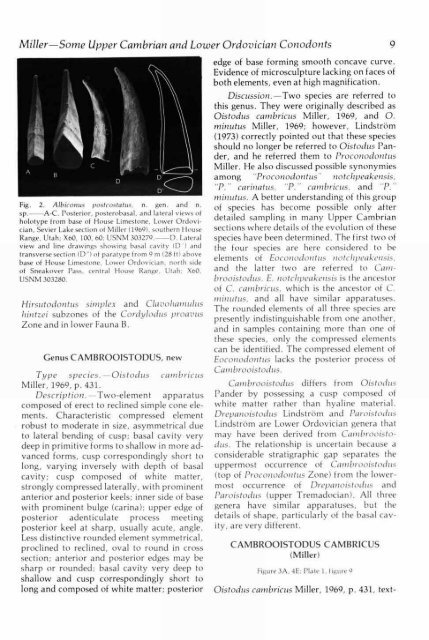View - KU ScholarWorks - University of Kansas
View - KU ScholarWorks - University of Kansas
View - KU ScholarWorks - University of Kansas
You also want an ePaper? Increase the reach of your titles
YUMPU automatically turns print PDFs into web optimized ePapers that Google loves.
Miller—Some Upper Cambrian and Lower Ordovician Conodonts 9<br />
Fig. 2. Albiconus postcostatus, n. gen. and n.<br />
sp. A-C. Posterior, posterobasal, and lateral views <strong>of</strong><br />
holotype from base <strong>of</strong> House Limestone, Lower Ordovician,<br />
Sevier Lake section <strong>of</strong> Miller (1969), southern House<br />
Range, Utah; X60, 100, 60; USNM 303279. D. Lateral<br />
view and line drawings showing basal cavity (D ) and<br />
transverse section (D") <strong>of</strong> paratype from 9m (28 It) above<br />
base <strong>of</strong> House Limestone, Lower Ordovician, north side<br />
<strong>of</strong> Sneakover Pass, central House Range, Utah; X60,<br />
USNM 303280.<br />
Hirsutodontus simplex and Clavolummlus<br />
hintzei subzones <strong>of</strong> the Cordylodus proavus<br />
Zone and in lower Fauna B.<br />
Genus CAMBROOISTODUS, new<br />
Type species. —Oistodus cambricus<br />
Miller, 1969, p. 431.<br />
Description. —Two-element apparatus<br />
composed <strong>of</strong> erect to reclined simple cone elements.<br />
Characteristic compressed element<br />
robust to moderate in size, asymmetrical due<br />
to lateral bending <strong>of</strong> cusp; basal cavity very<br />
deep in primitive forms to shallow in more advanced<br />
forms, cusp correspondingly short to<br />
long, varying inversely with depth <strong>of</strong> basal<br />
cavity; cusp composed <strong>of</strong> white matter,<br />
strongly compressed laterally, with prominent<br />
anterior and posterior keels; inner side <strong>of</strong> base<br />
with prominent bulge (caria); upper edge <strong>of</strong><br />
posterior adenticulate process meeting<br />
posterior keel at sharp, usually acute, angle.<br />
Less distinctive rounded element symmetrical,<br />
proclined to reclined, oval to round in cross<br />
section; anterior and posterior edges may be<br />
sharp or rounded; basal cavity very deep to<br />
shallow and cusp correspondingly short to<br />
long and composed <strong>of</strong> white matter; posterior<br />
edge <strong>of</strong> base forming smooth concave curve.<br />
Evidence <strong>of</strong> microsculpture lacking on faces <strong>of</strong><br />
both elements, even at high magnification.<br />
Discussion. —Two species are referred to<br />
this genus. They were originally described as<br />
Oistodus cambricus Miller, 1969, and O.<br />
inimitus Miller, 1969; however, Lindstrom<br />
(1973) correctly pointed out that these species<br />
should no longer be referred to Oistodus Pander,<br />
and he referred them to Proconodontus<br />
Miller. He also discussed possible synonymies<br />
among 'Proconodontus - notclipeakensis,<br />
carinatus, -P. - cambricus, and -P."<br />
minutus. A better understanding <strong>of</strong> this group<br />
<strong>of</strong> species has become possible only after<br />
detailed sampling in many Upper Cambrian<br />
sections where details <strong>of</strong> the evolution <strong>of</strong> these<br />
species have been determined. The first two <strong>of</strong><br />
the four species are here considered to be<br />
elements <strong>of</strong> Eoconodontus notclipeakensis,<br />
and the latter two are referred to Cambrooistodus.<br />
E. notclipeakensis is the ancestor<br />
<strong>of</strong> C. cambricus, which is the ancestor <strong>of</strong> C.<br />
wit/taus, and all have similar apparatuses.<br />
The rounded elements <strong>of</strong> all three species are<br />
presently indistinguishable from one another,<br />
and in samples containing more than one <strong>of</strong><br />
these species, only the compressed elements<br />
can be identified. The compressed element <strong>of</strong><br />
Eoconodontus lacks the posterior process <strong>of</strong><br />
Cambrooistodus.<br />
Cambrooistodus differs from Oistodus<br />
Pander by possessing a cusp composed <strong>of</strong><br />
white matter rather than hyaline material.<br />
Drepanoistodus LindstrOm and Paroistodus<br />
LindstrOm are Lower Ordovician genera that<br />
may have been derived from Cambrooistodus.<br />
The relationship is uncertain because a<br />
considerable stratigraphic gap separates the<br />
uppermost occurrence <strong>of</strong> Cambrooistodus<br />
(top <strong>of</strong> Proconodontus Zone) from the lowermost<br />
occurrence <strong>of</strong> Drepanoistodus and<br />
Paroistodus (upper Tremadocian). All three<br />
genera have similar apparatuses, but the<br />
details <strong>of</strong> shape, particularly <strong>of</strong> the basal cavity,<br />
are very different.<br />
CAMBROOISTODUS CAMBRICUS<br />
(Miller)<br />
Figure 3A, 4E; Plate 1, tigure 9<br />
Oistodus cambricus Miller, 1969, p. 431, text-
















